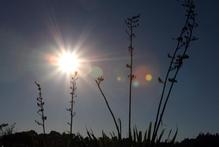
You do need to avoid excessive sun exposure to avoid skin cancers, but it's not as simple as that.
UV radiation likely causes over 90 per cent of all skin cancers and also increases the likelihood of cataracts and premature skin aging and causes immune suppression.
Both UVA and UVB radiation cause genetic damage and promote skin cancers. But because most sunscreens do not block out UVA radiation, skin damage can occur even when sunscreen is applied.
In addition to this, high SPF sunscreens can completely block vitamin D production by blocking UVB.
Because of all of this, sunscreens may falsely give a sense of safety in the sun.
Australia and NZ have the highest melanoma rates in the world, but also the highest sunscreen usage.
The negative publicity over excessive sun exposure over the past few years has resulted in such an efficient block out of the sun that we now have a vitamin D deficiency pandemic.
Worldwide, it is estimated to be around 50 per cent of the population.
Many melanomata occur on non sun-exposed areas - this could be related to a lack of vitamin D.
We know vitamin D helps prevent cancer so research is currently looking at the association between vitamin D deficiency and and melanoma.
So, why do we need vitamin D and how does it prevent cancer?
Sunlight is the main source of vitamin D in New Zealand. Many New Zealanders have insufficient vitamin D.
Vitamin D controls over 200 genes in all tissues of the body. Its benefits are extensive and include prevention of heart disease, autoimmune disorders, SAD, depression and sleep disorders. Vitamin D also helps melatonin production - this is an antioxidant.
Research has shown that vitamin D is a potent cell growth regulator and reduces metastases (the spread of cancer). Vitamin D has been shown to suppress the growth of melanoma cells in test tubes.
In one study, patients with the highest vitamin D levels had a 40 per cent reduction in skin cancer.
Sun exposure reduces the risk of certain other cancers, including non hodgkins lymphoma, breast cancer (by 50 per cent), prostate cancer and colon cancer.
One researcher reports that a lifetime's sun exposure is associated with a lower risk of melanoma. And that sun exposure is associated with increased melanoma survival.
This is also evidenced by the finding that malignant melanoma patients have been found to have lower vitamin D levels.
Places with less sunlight in the world have been found to have increased cancers of breast, colon, and prostate cancers.
At last, everyone has come to their senses and have suggested sensible sun exposure in New Zealand that enables vitamin D production. The major groups in New Zealand include: The Cancer Society, The Health Sponsorship Council, The Ministry of Health, the NZ Dermatological Society, Osteoporosis NZ and NIWA.
Collectively, they have published a Position Statement about the risks and benefits of sun exposure in NZ".
In summary: Sensible sun protection behaviour should not put people at risk of vitamin D deficiency.
The position statement's recommendations summarised:
1. Avoid sunburn - the worst risk for skin cancer is when you are sunburnt as a child then get low vitamin D as an adult.
2. Some sun exposure is recommended for vitamin D production - it is best to expose larger areas briefly than smaller areas over longer periods. Darker skins need more exposure though it's unsure how long.
3. Extra measures to get adequate vitamin D levels are needed in those at increased risk of vitamin D deficiency. Eg. the elderly, the obese, and those suffering from certain illnesses.
4. Those at high risk of cancer should discuss their vitamin D needs with doctor. They need to avoid sun exposure.
5. More research is needed for definite advice about times in the sun.
6. Solariums are dangerous and may emit much higher concentrations of UV radiation than the sun.
Dr.Frances Pitsilis



Reader Comments
to our Newsletter